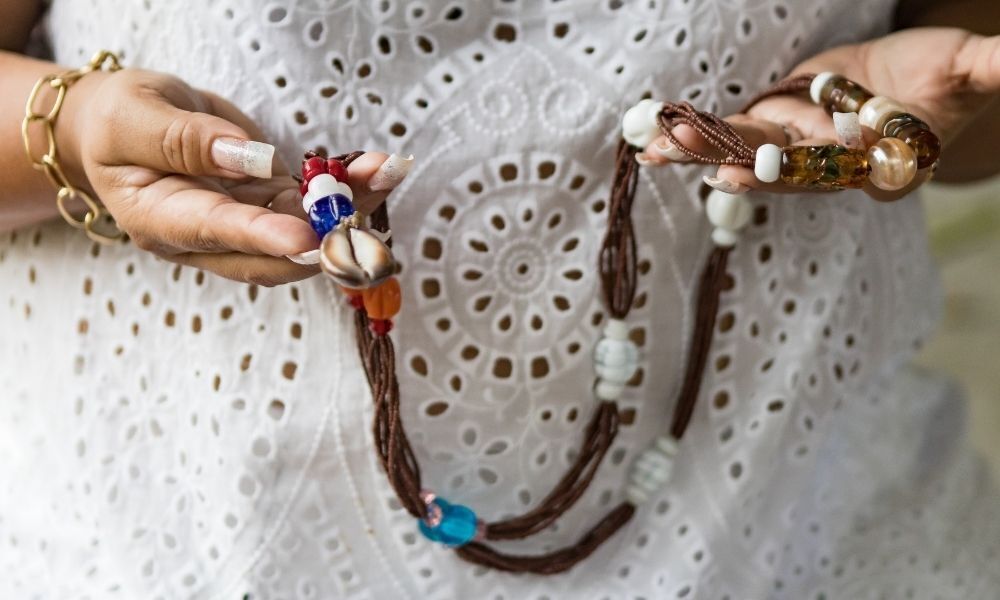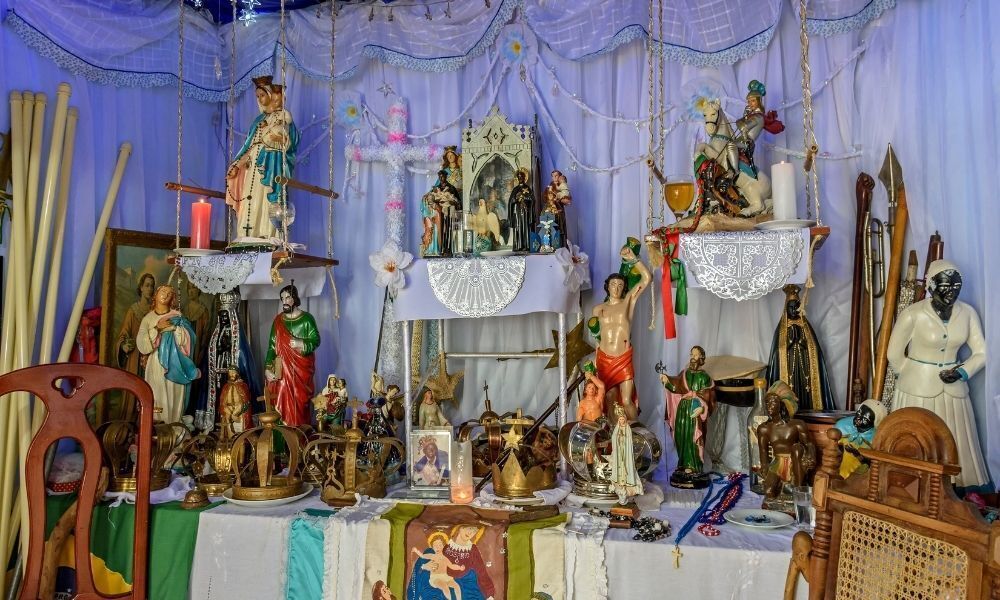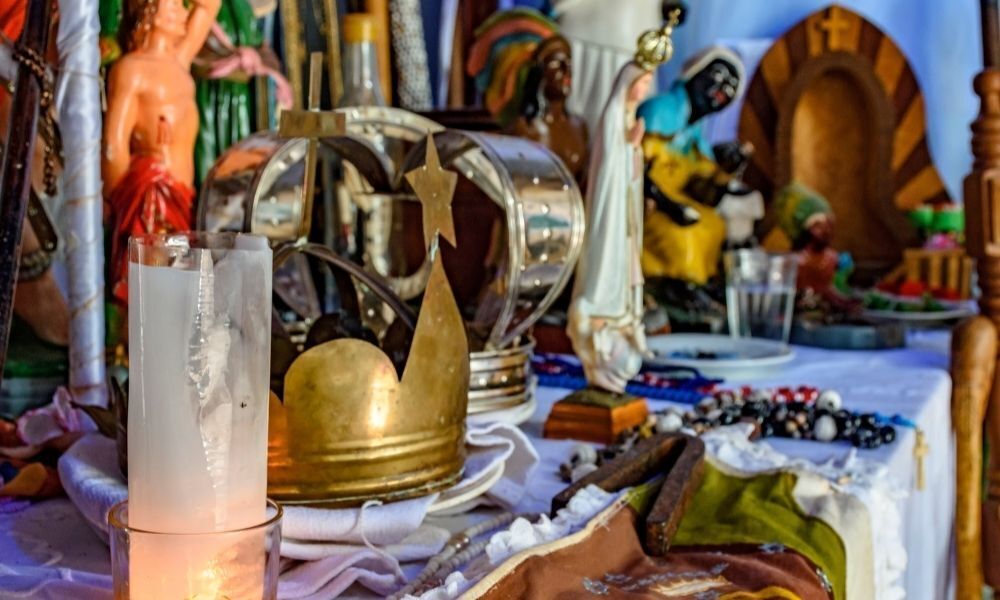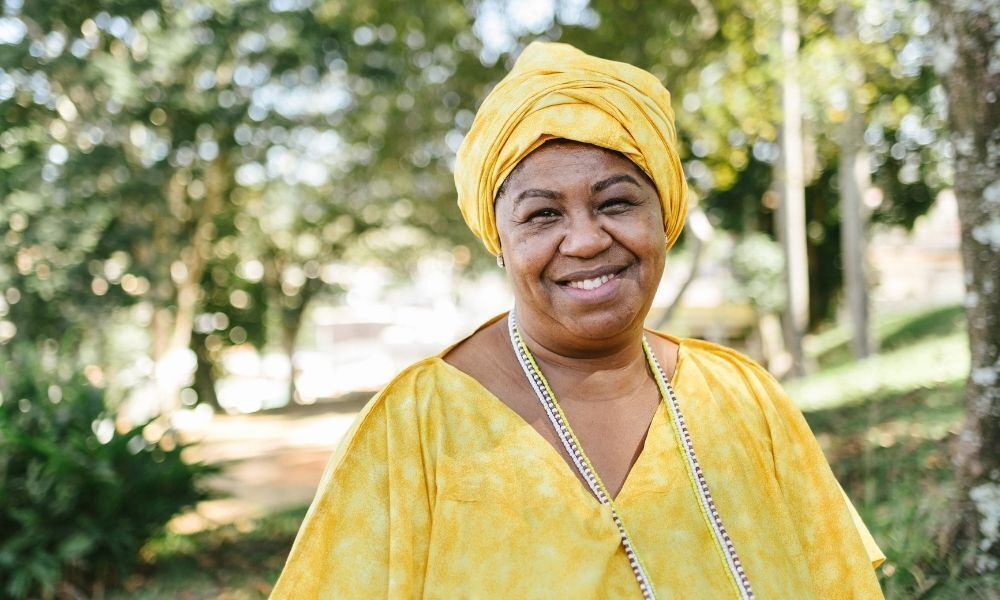Table of contents
Who is Logun Edé?

The warrior Logun Edé, or Logunedé, is an orixá of Candomblé, a religion of African origin very widespread in Brazil. His name comes from the city of his birth, which is precisely Edé, in Nigeria.
Although he is the smallest of all the orixás and even confused with a child because of his short stature, Logun Edé is one of the noblest hunters of Candomblé. Therefore, he is very brave, powerful and brave.
Besides, this orixá has some characteristics very similar to those of Ogum. Therefore, his explosive, merciless and bloodthirsty way is one of his most evident and observed points. Thus, he is one of the strongest orixás and a brave warrior.
Read this article and find out everything about Logun Edé!
The story of Logun Edé

Like all orixás of the African matrix religions, Logun Edé has two origins in Umbanda, from Oxum and Oxóssi. In addition, he was raised by Iansã and Ogum, but had a reunion with his mother, Oxum. Check more below!
Logun Edé in Umbanda
Logun Edé is one of the best known orixás in Umbanda, a feared, respected, bloodthirsty and imposing hunter warrior. He is also one of the most beautiful orixás, which is one of his main characteristics.
In Umbanda, Logun Edé is the orixá that represents wealth. His garments are composed of cloths and animal skins, usually of leopard, which is the animal associated with him for grace, strength and beauty.
On his head, he carries a tiara with large blue feathers. In addition, like the warrior that he is, he carries on his body a spear, a bow, an arrow and a mirror.
Its origin from Oxum and Oxóssi
Because it has a very old history, with parts originating from another continent and even with other languages involved, there are some disagreements regarding the origin of Logun Edé.
This disagreement lies in the statement of who his father is: Oxóssi, Ogum or Erinlé. After all, Logun Edé would have had a very close, almost paternal, relationship with Ogum, but the most accepted is that he is the son of Oxóssi.
However, regarding maternity, there is no doubt that LogunEdé's mother is Oxum, patroness of fertility, beauty and sensitivity. In light of this, there is the affiliation of this orixá.
Created by Iansã and Ogum
It is known that Logun Edé was abandoned in a river when he was still a child, so he did not have the presence of his parents, Oxum and Oxóssi, during his entire life.
Despite this, he developed a very close relationship with Ogum after this orixá had found him. Ogum, like Logun Edé, is a warrior and brave orixá.
In addition, another orixá that participated in the creation of the warrior, as a female figure, is Iansã. She is the goddess of storms and whirlwinds, besides also being a warrior.
The reunion with his mother Oxum
Logun Edé, thrown into the sea when he was just a child, got lost from his mother, Oxum, and was raised by Iansã and Ogum, who found him in the riverbed. However, Oxum did not even know that her son was alive, as she thought he had drowned in the river.
As an adult, Logun Edé was curious and went into the forest when he came across a river that seemed to be calling him. He stopped at the riverbank and stared at his reflection, until he noticed the figure of a woman, who turned out to be his mother Oxum.
The syncretism of Logun Edé
Like all other orixás of the religions of African origin, Logun Edé is the result of a mixture with other religions. Therefore, this orixá has influence from Catholicism, with Saint Expedito and Saint Michael the Archangel, and even from Greek mythology, with Hermaphroditus.
Saint Expedito
St. Expedito is the Catholic Church's saint of emerging and lost causes. However, despite being canonized, there are doubts about his real existence.
However, the story goes that Saint Expedito was a soldier in the army who decided to convert. However, on his way he spotted a crow who told him to leave it for the next day, but he killed the crow and moved on.
However, after assuming his faith in God, Santo Expedito was killed by the army. Thus, he was regarded as a brave man who did not give up professing his faith. In this way, the courage seen in him and in Logun Edé is the reason for syncretism.
Saint Michael the Archangel
Archangels are the highest angelic rank in the divine and heavenly order. They are great warriors, responsible for guarding and protecting the Kingdom of Heaven. Saint Michael the Archangel is one of these heavenly warriors. In fact, he was the chief of the seven archangels during the rebellion in heaven, and fought and defeated evil, expelling Lucifer from heaven and sending him to hell.
Therefore, the religious syncretism of the two religious figures comes from the courageous warrior bearing of Saint Michael the Archangel, which resembles that of Logun Edé, the hunter and warrior orixá.
Hermaphroditus of Greek mythology
Hermaphroditus, son of Aphrodite, goddess of love, and Hermes, god of travelers, was a being who had both sexes in his body, that is, he was female and male.
According to Greek mythology, he was a beautiful boy when he had relations with the nymph Salmacis, a deity who inhabits rivers, streams and waterfalls. Therefore, from this moment on, the son of the two gods became Hermaphroditus.
Thus, Afro-Brazilian religion rescued this characteristic from Greek mythology and applied it to Logun Edé. When he spends 6 months with his father, he is a man, and the rest of the time, when he is with his mother, he is a woman.
Logun Edé's Characteristics

Logun Edé has particular characteristics that differentiate him from the other orixás of Umbanda. Among them are his vanity, his wisdom and the fact that he is the lord of fishing. Check more below!
Lord of Fishing
First, to understand the designation "Lord of Fishing", one must understand the origin of Logun Edé. He spends 6 months with his father, Oxóssi, and 6 months with his mother, Oxum, in fresh water.
Therefore, this frequent contact with his mother and his closeness to the waters gave him a great intimacy with water and with everything it produces and offers.
This is a particular characteristic that comes from his maternal side and has no relation to syncretism.
Oxum's vanity
Oxum is the great mother of the orixás, the most important female figure in Umbanda. She appears as a beautiful, well-dressed woman with white cloths on her body and head.
In addition, she is depicted with various jewels, as she is the goddess of precious stones and wealth, and is also shown with a mirror in her hand while nursing a child in the river.
In some situations, Logun Edé also appears with a mirror in hand, representing vanity. After all, it was from his mother that he inherited this characteristic.
The wisdom of Oxóssi
Oxóssi, father of Logun Edé, is the orixá of hunting, who is knowledgeable about the forest and a great warrior. Thus, he is a guardian of the forest and protects the flora and fauna that exist there. However, it is not only about the forest that the wisdom of Oxóssi is linked. This orixá also represents the mental characteristics that stimulate knowledge.
According to him, one must know the world in order to know oneself and thus help others. Therefore, Logun Edé's wisdom was inherited from his father, Oxóssi, the warrior hunter.
It has no qualities
Logun Edé has different characteristics, influenced mainly by his mother, Oxum, the goddess of the rivers, and also by his father, Oxóssi, the warrior god of hunting.
However, he is also an orixá who does not need to define his characteristics, because, by having the two energies, that of the father and that of the mother, plus his own, he can become whatever he wants and whenever he wants.
Thus, he is the only one among the orixás who does not have specific qualities. His dual origin allows transformations that can bring about other distinct characteristics.
To relate to Logun Edé

To relate to Logun Edé, there are some ways that can help you achieve your grace and please this powerful orixá. Some of them are: the day of the year, the greeting, the symbol and, of course, the offerings. Check them out below!
Day of the year of Logun Edé
The orixás have days of the year when they are celebrated and receive offerings, and on this day they are more likely to fulfill requests from their devotees.
Despite this, it is possible to celebrate them every day, but on these specific days the celebration is special. Therefore, following the religious syncretism with Santo Expedito - the Catholic saint - Logun Edé's day is also celebrated on April 19th.
In addition, on April 19 is also celebrated the "day of the Indian", Brazil. Although nothing is confirmed, the status of hunter and protector of the waters of Logun Edé may have been associated with the Indians and, therefore, there is the coincidence of the date.
Day of the week of Logun Edé
The orixás can and should receive homage on other days of the year, besides their special days. However, there are certain days of the week for devotees to make offerings to their entities.
In other cultures, such as Norse and Greek, Thursday is known as the day of thunder and storms. In fact, the origin of the name of this day of the week translates as the day of Jupiter or Thor, gods of thunder.
Nevertheless, in Umbanda and Candomblé, the day chosen to honor Logun Edé is Thursday.
Salutation to Logun Edé
Greetings are an essential part of the cult of the orixás and entities of the Afro-Brazilian religions. Thus, for each of the orixás, there is a special greeting called a salutation.
These should be said exactly to greet the orixás and celebrate their presence when they manifest themselves. In this way, Logun Edé is also received with a special greeting.
There are two versions of the Logun Edé greeting: firstly, the best known is "Loci, Loci Logun" and secondly, there is the "Logun ô akofá". Although different, both mean the same thing: warrior prince.
Symbol of Logun Edé
Logun Edé, as well as other Candomblé orixás, has symbols that refer to his nature, his personality, his principles and even his origin.
In this sense, Logun Edé has symbols that refer to his status as a hunting warrior. First, there are the symbols of the hunting spear and the machete, clearly alluding to his status.
Logun Edé also carries symbols with names of African origin, such as the Ofá, a weapon that resembles a bow and arrow or a harpoon, and the Oguê, an object made of ox horn used as an instrument and also to attract abundance.
Element of Logun Edé
According to stories in Umbanda and Candomblé, Logun Edé, after his reunion with his mother, began to spend half the year in one place and the other half in another.
Because of this, he lives 6 months on earth with his father, Oxóssi. He spends this time learning about the forest, hunting and protecting the fauna and flora of the forest. Therefore, he spends the other 6 months with his mother, Oxum.
Then, with his mother, goddess of the rivers, Logun Edé spends 6 months under water, learning to fish. Thus, his two elements are precisely earth and water, referring to his parents.
Colors of Logun Edé
The African matrix religions, in fact, have as one of their main characteristics the use of cheerful, solid, strong and very beautiful colors. Thus, the orixás have shades that they like the most and that should be used.
In this sense, in the case of Logun Edé, his favorite colors are blue and yellow. This combination is found in his clothes, with the yellow of the leopard skin and the blue of the bird feathers on his head.
However, there is one particularity: when someone is to incorporate this orixá, the colors used should be white and red, but mainly red.
Foods of Logun Edé
The entities or orixás have many similarities with human beings. Unlike other religions that have sought to sanctify their deities, in Candomblé, they are not dehumanized and share many characteristics with their devotees.
In fact, one of them is the taste for food. Certainly, the orixás appreciate being presented with their favorite dishes in offerings. Therefore, it is necessary to know them.
In the case of Logun Edé, refried beans, corn, onions, eggs, and olive oil are his favorites. In addition, some people like to increase the offering with shrimp and coconut.
Offerings to Logun Edé
In Candomblé, offerings are a way to thank the entities and orixás, ask for blessings or for help in some aspect of life. In addition, they also serve to simply celebrate the presence of these divinities.
Therefore, when preparing an offering, one needs to know the orixá to whom the offering is destined, his preferences and even the things he does not like.
In the case of Logun Edé, the foods that can irritate him are: chicken, goat, kid, honey and mango. Now, his favorites are: refried beans, shrimp, onions, dende oil, eggs and coconut.
Characteristics of the sons of Logun Edé

Being a son of an orixá in Candomblé or Umbanda means that that person is under the influence of a certain deity. Therefore, he carries some characteristics that come from these sacred beings in his personality. To learn more about these individuals, read the following topics!
Artistic Personality
The sons of Logun Edé tend to have a very keen artistic eye. They like to work on their works in order to leave them in their best version.
This characteristic comes directly from Logun Edé, who is very vain and one of the most beautiful orixás of the Afro-Brazilian religions Candomblé and Umbanda.
So while this is a good trait, these children must be careful not to overdo perfectionism and become frustrated or disgusted with the arts they do.
Contradiction and instability
Logun Edé himself has a reputation for being unstable and contradictory, so there is an explanation. After all, Logun Edé carries three different energies: that of his father, Oxóssi, that of his mother, Oxum, and his own.
Thus, the junction of the three energies, one connected to water, another connected to earth and a third, which can be only what he wants to be, causes strangeness in some people, who do not understand his nature.
Therefore, their children also have this characteristic of being able to change their nature in a simple way. Thus, they end up being known for instability and contradiction.
Fluidity between genres
The story about Logun Edé's childhood has become widespread. According to beliefs, he was separated from his parents in infancy when they threw him into a river.
Thus, when, as an adult, he found his mother again, he began to divide his time between his father's house, the forest, and his mother's, the rivers. Another part of this story states that Logun Edé becomes a woman when he is with his mother and becomes a boy again when he goes to the forest.
Therefore, this orixá is of fluid gender. That is, he can identify himself as male or female from time to time.
Luxury and style
There is an untruth that surrounds the beliefs of Candomblé and Umbanda regarding Logun Edé. Thus, some people believe that he is a child or a teenager and that he is ugly and short.
In fact, Logun Edé is a big and strong man and one of the most beautiful orixás in Candomblé. In addition, he is the orixá of wealth and, for this reason, he is always well-dressed and well-groomed.
Therefore, with their children, this is no different. They are reputed to care a lot about luxury and style, so they attach themselves to material goods and fashion trends.
What does Logun Edé's ambiguity teach us?

As an orixá that can transit between various energies, Logun Edé has different experiences and knowledge and a lot of freedom to relate to nature. Thus, he can absorb everything it has to teach and offer.
In this way, he is not tied to only one personality or one gender and even has varied maternal and paternal influences. In this way, he demonstrates his diverse figure, full of culture and teachings.
In this sense, Logun Edé's ambiguity teaches us not to be attached to one single thing and that nothing is immutable. Therefore, variations are healthy and important for the growth and maturation of the individual.

